1996 HONDA ODYSSEY warning
[x] Cancel search: warningPage 198 of 240
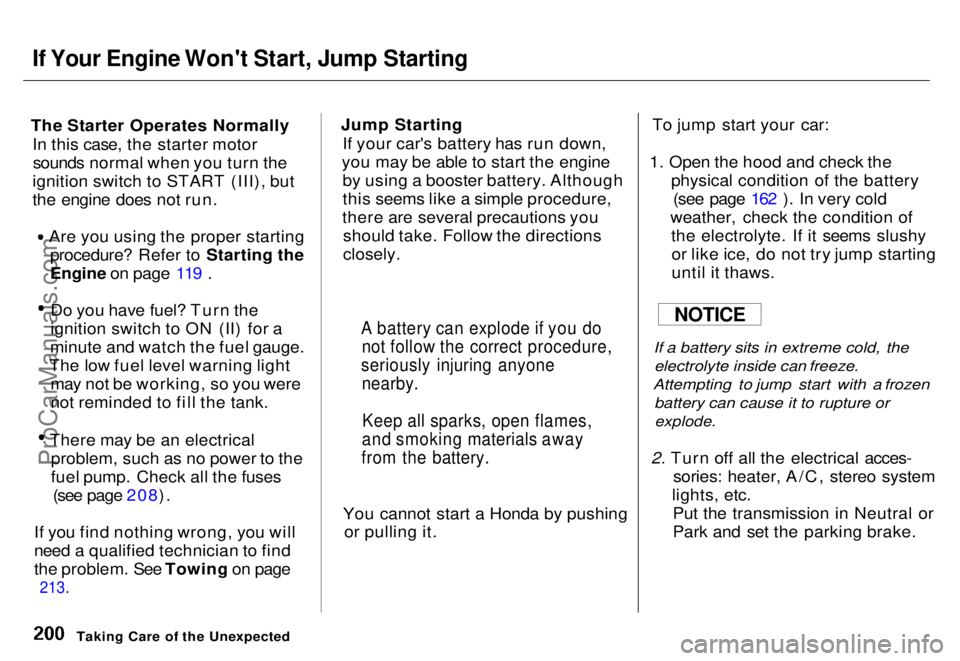
If Your Engine Won't Start, Jump Starting
The Starter Operates Normally In this case, the starter motorsounds normal when you turn the
ignition switch to START (III), but
the engine does not run. Are you using the proper starting
procedure? Refer to Starting the
Engine on page 119 . Do you have fuel? Turn the
ignition switch to ON (II) for a
minute and watch the fuel gauge.
The low fuel level warning light may not be working, so you were
not reminded to fill the tank. There may be an electrical
problem, such as no power to the
fuel pump. Check all the fuses (see page 208).
If you find nothing wrong, you will
need a qualified technician to find
the problem. See Towing on page
213.
Jump Starting
If your car's battery has run down,
you may be able to start the engine by using a booster battery. Although
this seems like a simple procedure,
there are several precautions you should take. Follow the directions
closely.
You cannot start a Honda by pushing or pulling it. To jump start your car:
1. Open the hood and check the physical condition of the battery(see page 162 ). In very cold
weather, check the condition of the electrolyte. If it seems slushyor like ice, do not try jump starting
until it thaws.
If a battery sits in extreme cold, the
electrolyte inside can freeze.
Attempting to jump start with a frozen battery can cause it to rupture or
explode.
2. Turn off all the electrical acces- sories: heater, A/C, stereo system
lights, etc. Put the transmission in Neutral or
Park and set the parking brake.
Taking Care of the Unexpected
NOTICE
A battery can explode if you do
not follow the correct procedure,
seriously injuring anyone nearby.
Keep all sparks, open flames,
and smoking materials away
from the battery.ProCarManuals.coms t Main Menu Table of Contents
Page 200 of 240
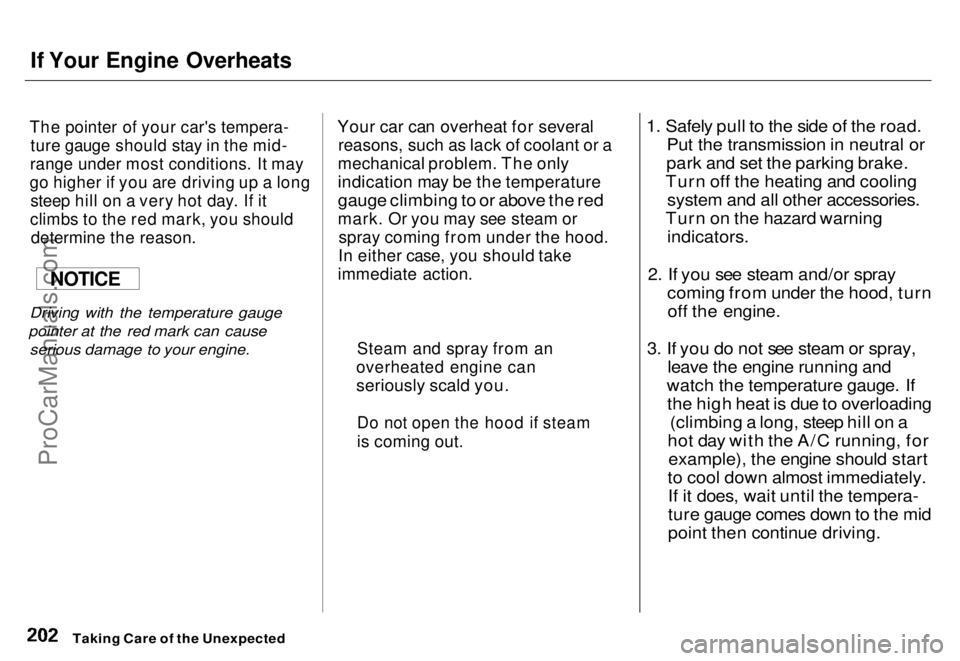
If Your Engine Overheats
The pointer of your car's tempera-
ture gauge should stay in the mid-
range under most conditions. It may
go higher if you are driving up a long
steep hill on a very hot day. If it
climbs to the red mark, you should
determine the reason.
Driving with the temperature gauge
pointer at the red mark can cause serious damage to your engine.
Your car can overheat for several
reasons, such as lack of coolant or a
mechanical problem. The only
indication may be the temperature
gauge climbing to or above the red
mark. Or you may see steam or
spray coming from under the hood.
In either case, you should take
immediate action.
1. Safely pull to the side of the road.
Put the transmission in neutral or
park and set the parking brake.
Turn off the heating and cooling system and all other accessories.
Turn on the hazard warning indicators.
2. If you see steam and/or spray coming from under the hood, turnoff the engine.
3. If you do not see steam or spray, leave the engine running and
watch the temperature gauge. If the high heat is due to overloading (climbing a long, steep hill on a
hot day with the A/C running, for example), the engine should start
to cool down almost immediately. If it does, wait until the tempera-
ture gauge comes down to the mid
point then continue driving.
Taking Care of the Unexpected
NOTICE
Steam and spray from an
overheated engine can
seriously scald you.
Do not open the hood if steam
is coming out.ProCarManuals.coms t Main Menu Table of Contents
Page 220 of 240

Tire Information
Traction
The traction grades, from highest to lowest, are A, B, and C, and they
represent the tire's ability to stop on
wet pavement as measured under controlled conditions on specified
government test surfaces of asphalt and concrete. A tire marked C may
have poor traction performance.
Warning: The traction grade as- signed to this tire is based on brak-
ing (straight ahead) traction tests and does not include cornering (turning) traction. Temperature
The temperature grades are A (the highest), B, and C, representing the
tire's resistance to the generation of
heat and its ability to dissipate heat
when tested under controlledconditions on a specified indoor
laboratory test wheel. Sustained high
temperature can cause the material of the tire to degenerate and reduce
tire life, and excessive temperature can lead to sudden tire failure. The
grade C corresponds to a level of
performance which all passenger car
tires must meet under the Federal Motor Vehicle Safety Standard No.109. Grades B and A represent
higher levels of performance on the laboratory test wheel than theminimum required by law. Warning: The temperature grade for
this tire is established for a tire thatis properly inflated and not over-
loaded. Excessive speed, underinfla-
tion, or excessive loading either separately or in combination, can
cause heat build-up and possible tire
failure.
Technical InformationProCarManuals.comMain Menu s t Table of Contents
Page 234 of 240
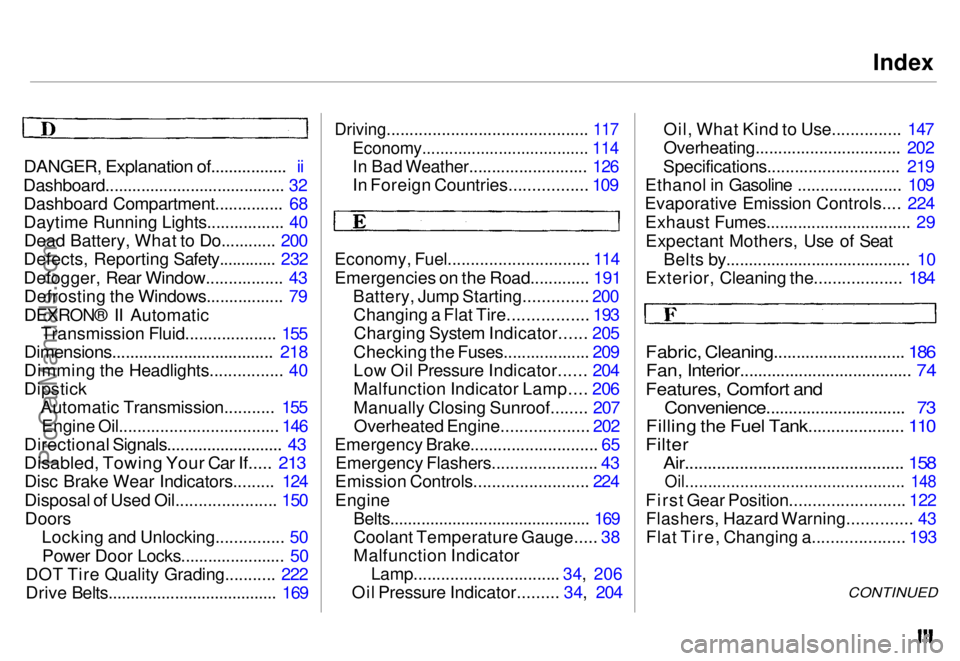
Index
DANGER, Explanation of................. ii
Dashboard........................................ 32 Dashboard Compartment............... 68
Daytime Running Lights................. 40Dead Battery, What to Do............ 200
Defects, Reporting Safety............. 232
Defogger, Rear Window................. 43 Defrosting the Windows................. 79
DEXRON® II Automatic Transmission Fluid.................... 155
Dimensions.................................... 218
Dimming the Headlights................ 40
Dipstick Automatic Transmission........... 155
Engine Oil................................... 146
Directional Signals.......................... 43
Disabled, Towing Your Car If..... 213
Disc Brake Wear Indicators......... 124
Disposal of Used Oil...................... 150Doors Locking and Unlocking............... 50
Power Door Locks....................... 50
DOT Tire Quality Grading........... 222
Drive Belts...................................... 169
Driving............................................ 117
Economy..................................... 114
In Bad Weather.......................... 126
In Foreign Countries................. 109
Economy, Fuel............................... 114
Emergencies on the Road............. 191
Battery, Jump Starting.............. 200
Changing a Flat Tire................. 193
Charging System Indicator...... 205
Checking the Fuses................... 209
Low Oil Pressure Indicator...... 204
Malfunction Indicator Lamp.... 206
Manually Closing Sunroof........ 207
Overheated Engine................... 202
Emergency Brake............................ 65
Emergency Flashers....................... 43
Emission Controls......................... 224
Engine
Belts............................................. 169
Coolant Temperature Gauge..... 38
Malfunction Indicator
Lamp................................ 34,
206
Oil Pressur e
Indicator......... 34, 204Oil, What Kind to Use............... 147
Overheating................................ 202
Specifications............................. 219
Ethanol in Gasoline ....................... 109
Evaporative Emission Controls.... 224
Exhaust Fumes................................ 29Expectant Mothers, Use of Seat Belts by......................................... 10
Exterior, Cleaning the................... 184
Fabric, Cleaning............................. 186
Fan, Interior...................................... 74
Features, Comfort and
Convenience............................... 73
Filling the Fuel Tank..................... 110
Filter
Air................................................ 158
Oil................................................ 148
First Gear Position......................... 122
Flashers, Hazard Warning.............. 43
Flat Tire, Changing a.................... 193
CONTINUEDProCarManuals.comMain Menu s t
Page 235 of 240
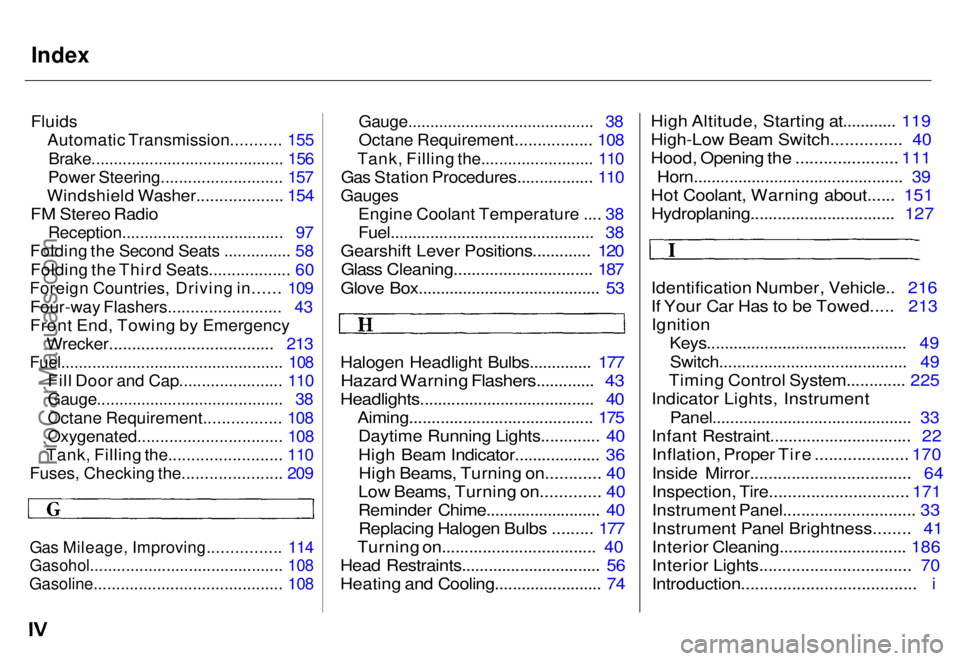
Index
Fluids
Automatic Transmission........... 155
Brake........................................... 156
Power Steering........................... 157
Windshield Washer................... 154
FM Stereo Radio
Reception.................................... 97
Folding the Second Seats ............... 58
Folding the Third Seats.................. 60
Foreign Countries, Driving in...... 109
Four-way Flashers......................... 43
Front End, Towing by Emergency
Wrecker.................................... 213
Fuel.................................................. 108
Fill Door and Cap....................... 110
Gauge.......................................... 38
Octane Requirement................. 108
Oxygenated................................ 108
Tank, Filling the......................... 110
Fuses, Checking the...................... 209
Gas Mileage, Improving................ 114
Gasohol........................................... 108
Gasoline.......................................... 108
Gauge.......................................... 38
Octane Requirement................. 108
Tank, Filling the......................... 110
Gas Station Procedures................. 110
Gauges Engine Coolant Temperature .... 38
Fuel.............................................. 38
Gearshift Lever Positions............. 120 Glass Cleaning............................... 187
Glove Box......................................... 53
Halogen Headlight Bulbs.............. 177
Hazard Warning Flashers............. 43
Headlights....................................... 40
Aiming......................................... 175Daytime Running Lights............. 40
High Beam Indicator................... 36High Beams, Turning on............ 40
Low Beams, Turning on............. 40
Reminder Chime.......................... 40 Replacing Halogen Bulbs ......... 177
Turning on.................................. 40
Head Restraints............................... 56
Heating and Cooling........................ 74 High Altitude, Starting at............ 119
High-Low Beam Switch............... 40
Hood, Opening the ...................... 111
Horn............................................... 39
Hot Coolant, Warning about...... 151 Hydroplaning................................ 127
Identification Number, Vehicle.. 216
If Your Car Has to be Towed..... 213Ignition
Keys............................................. 49
Switch.......................................... 49
Timing Control System............. 225
Indicator Lights, Instrument
Panel............................................. 33
Infant Restraint............................... 22 Inflation, Proper Tire .................... 170
Inside Mirror................................... 64
Inspection, Tire.............................. 171
Instrument Panel............................. 33
Instrument Panel Brightness........ 41
Interior Cleaning............................ 186
Interior Lights................................. 70
Introduction...................................... iProCarManuals.comMain Menu s t
Page 239 of 240
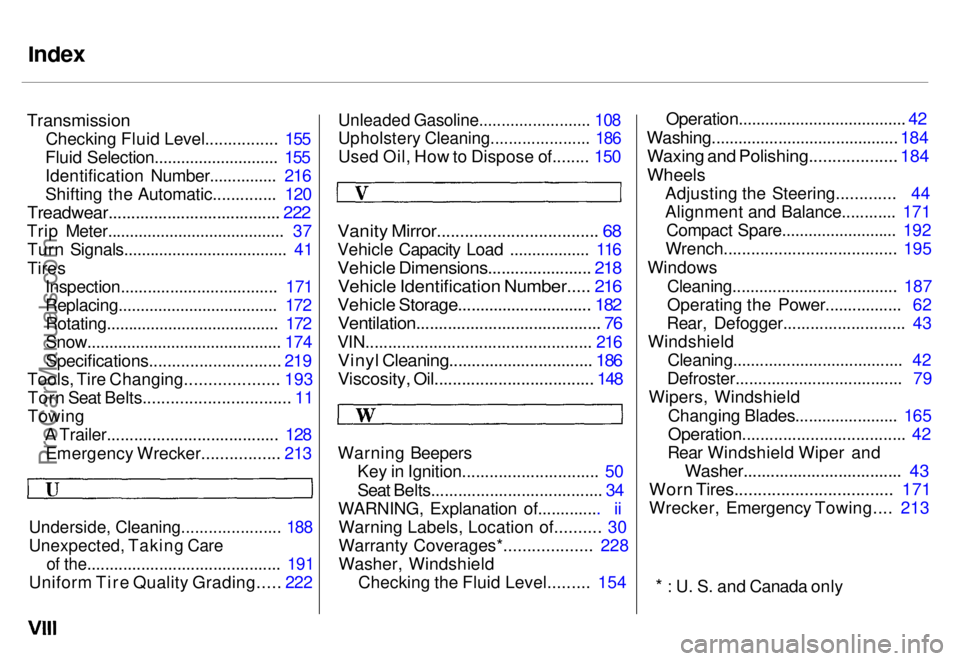
Index
Transmission
Checking Fluid Level................ 155
Fluid Selection............................ 155
Identification Number............... 216
Shifting the Automatic.............. 120
Treadwear...................................... 222
Trip Meter........................................ 37 Turn Signals..................................... 41
Tires Inspection................................... 171
Replacing.................................... 172Rotating....................................... 172
Snow............................................ 174
Specifications............................. 219
Tools, Tire Changing.................... 193 Torn Seat Belts................................ 11
Towing A Trailer...................................... 128
Emergency Wrecker................. 213
Underside, Cleaning...................... 188
Unexpected, Taking Care
of the........................................... 191
Uniform Tire Quality Grading..... 222
Unleaded Gasoline......................... 108
Upholstery Cleaning...................... 186
Used Oil, How to Dispose of........ 150
Warning Beepers Key in Ignition..............................
50
Seat Belts..................................... .
34
WARNING, Explanation of.............. ii Warning Labels, Location of.......... 30
Warranty Coverages*................... 228
Washer, Windshield Checking the Fluid Level......... 154
Operation...................................... 42
Washing.......................................... 184
Waxing and Polishing................... 184
Wheels
Adjusting the Steering............. 44
Alignment and Balance............ 171Compact Spare.......................... 192
Wrench...................................... 195
Windows Cleaning..................................... 187
Operating the Power................. 62
Rear, Defogger........................... 43
Windshield Cleaning...................................... 42
Defroster..................................... 79
Wipers, Windshield
Changing Blades....................... 165
Operation.................................... 42
Rear Windshield Wiper and
Washer................................... 43
Worn Tires.................................. 171
Wrecker, Emergency Towing.... 213
* : U. S. and Canada only
Vanity Mirror................................... 68
Vehicle Capacity Load .................. 116
Vehicle Dimensions....................... 218
Vehicle Identification Number..... 216
Vehicle Storage.............................. 182
Ventilation......................................... 76
VIN.................................................. 216
Vinyl Cleaning................................ 186
Viscosity, Oil................................... 148ProCarManuals.comMain Menu s t